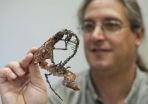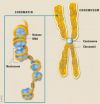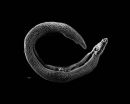(Press-News.org) GAINESVILLE, Fla. --- University of Florida researchers presenting new fossil evidence of an exceptionally well-preserved 55-million-year-old North American mammal have found it shares a common ancestor with rodents and primates, including humans.The study published today in the online edition of the Zoological Journal of the Linnean Society, describes the cranial anatomy of the extinct mammal, Labidolemur kayi.
High resolution CT scans of the specimens allowed researchers to study minute details in the skull, including bone structures smaller than one-tenth of a millimeter. Similarities in bone features with other mammals show L. kayi's living relatives are rodents, rabbits, flying lemurs, tree shrews and primates.
Researchers said the new information will aide future studies to better understand the origin of primates.
"The specimens are among the only skulls of apatemyids known that aren't squashed completely flat," said study co-author Jonathan Bloch, an associate curator of vertebrate paleontology at the Florida Museum of Natural History on the UF campus. "They're preserved in three dimensions, which allows us to look at the morphology of the bones in a way that we never could before."
Scientists have disputed the relationships of Apatemyidae, the family that includes L. kayi, for more than a century because of their unusual physical characteristics. With can opener-shaped upper front teeth and two unusually long fingers, apatemyids have been compared to a variety of animals, from opossums to woodpeckers.
"There are only a few examples in the history of mammals where you get such an incredibly odd ecological adaptation," Bloch said.
Like a woodpecker's method of feeding, L. kayi used percussive foraging, or tapping on trees, to locate insects. It stood less than a foot tall, was capable of jumping between trees and looked like a squirrel with a couple of really long fingers, similar to the aye-aye, a lemur native to Madagascar, Bloch said.
Apatemyids have been preserved for tens of millions of years and are well known from Europe and North America.
The skeletons analyzed in the publication were recovered from freshwater limestone in the Bighorn Basin by co-author Peter Houde of New Mexico State University. Located just east of Yellowstone National Park in Wyoming, the site is known as one of the best in the world for studying the evolution of mammals during the 10 million years following the extinction of the dinosaurs, Bloch said.
Mary Silcox, first author of the study and a research associate at the Florida Museum, said scans of the specimens began about 10 years ago, during her postdoctoral work at The Pennsylvania State University.
"It's not like medical CT, it's actually an industrial CT scanner," said Silcox, an assistant professor of anthropology at the University of Toronto Scarborough. "Because this is a small animal, we needed to be able to study it at a very high resolution. The high resolution CT data were a critical part."
Doug Boyer of Stony Brook University is also a co-author of the study, part of the team's larger research to understand the relationships of apatemyids to other mammals. Bloch and colleagues are currently writing a detailed analysis of L. kayi's skeleton.
John Wible, curator of mammals at the Carnegie Museum of Natural History and one of the researchers who reviewed the study, said it provides valuable information for understanding the evolutionary relationships of mammals.
"It is now clear that any assessment of the origins of primates in the future will have to include apatemyids," Wible said. "Apatemyids are not some freakish dead-end, but significant members of our own history."
INFORMATION:
University of Florida research provides new understanding of bizarre extinct mammal
New fossil evidence of 55-million-year old mammal related to rodents and primates
2010-10-13
ELSE PRESS RELEASES FROM THIS DATE:
On the trail of the epigenetic code
2010-10-13
The genetic inherited material DNA was long viewed as the sole bearer of hereditary information. The function of its packaging proteins, the histones, was believed to be exclusively structural. Additional genetic information can be stored, however, and passed on to subsequent generations through chemical changes in the DNA or histones. Scientists from the Max Planck Institute for Biophysical Chemistry in Göttingen have succeeded in creating an experimental system for testing the function of such chemical histone modifications and their influence on the organism. Chemical ...
Smaller and cheaper but 300 times more intense
2010-10-13
More brilliant X-rays, more cost-effective methods for developing new energy sources and advanced manufacturing processes are just some of the benefits which may come from a novel technology, proven at the theoretical level by a consortium of British and European laser scientists. The research, led by scientists at the Science and Technology Facilities Council's Central Laser Facility is published in this week's edition of Nature Physics (October 10 2010).
A team of scientists from the Instituto Superior Tecnico in Lisbon, Imperial College London, and the Universities ...
CU-Boulder student dust counter breaks distance record on New Horizons mission to Pluto
2010-10-13
A University of Colorado at Boulder space dust counter designed, tested and operated by students that is flying aboard NASA's New Horizons mission to Pluto now holds the record for the most distant working dust detector ever to travel through space.
The instrument on the New Horizons mission -- officially named the Venetia Burney Student Dust Counter, or SDC, after an 11-year-old English girl who named Pluto more than 75 years ago -- reached a distance of 1.67 billion miles from Earth on Oct. 10. Designed by a student team from CU-Boulder's Laboratory for Atmospheric ...
Mathematics and the environment
2010-10-13
Providence, RI---It was a mathematician, Joseph Fourier (1768-1830),
who coined the term "greenhouse effect". That this term, so commonly
used today to describe human effects on the global climate, originated
with a mathematician points to the insights that mathematics can offer
into environmental problems. Three articles in the November 2010
issue of the Notices of the American Mathematical Society examine ways
in which mathematics can contribute to understanding environmental and
ecological issues.
"Earthquakes and Weatherquakes: Mathematics and Climate Change", ...
Prenatal treatment of congenital toxoplasmosis could reduce the risk of brain damage
2010-10-13
Prenatal treatment of congenital toxoplasmosis with antibiotics might substantially reduce the proportion of infected fetuses that develop serious neurological sequelae (brain damage, epilepsy, deafness, blindness, or developmental problems) or die, and could be particularly effective in fetuses whose mothers acquired Toxoplasma gondii, the parasite that causes toxoplasmosis, during the first third of pregnancy. These are the findings of an observational study by Ruth Gilbert from the UCL Institute of Child Health, London, UK, and colleagues and published in this week's ...
Being more realistic about the public health impact of genomic medicine
2010-10-13
Wayne Hall, Rebecca Mathews and Katherine Morley discuss the limitations of genomic risk prediction for population-level preventive health care. Whilst genome-wide association studies and genomic sequencing have the potential to reveal susceptibilities to disease, they sound a note of caution about widescale implementation of such tests. In particular they point out that before genomic information is used in public health screening, it must first be shown that it predicts disease risk better than phenotypic information. They go on to point out that before genomic information ...
Economic advantage to pediatric ondansetron administration in emergency departments
2010-10-13
In research published this week in PLoS Medicine, Stephen Freedman (University of Toronto) and colleagues performed a cost analysis of the emergency department administration of oral ondansetron to children with dehydration and vomiting secondary to gastroenteritis and found that this treatment could provide substantial economic, as well as clinical, benefit.
The researchers analyzed the costs of the administration of oral ondansetron in both the US and Canada, if routinely given to children with gastroenteritis-induced vomiting and dehydration in the emergency department ...
Study of planarian hormones may aid in understanding parasitic flatworms
2010-10-13
CHAMPAIGN, Ill. — A study of peptide hormones in the brain of a seemingly primitive flatworm reveals the surprising complexity of its nervous system and opens up a new approach for combating a major parasitic disease, researchers report.
The study appears in the open-access journal PLoS Biology.
The planarian flatworm, Schmidtea mediterranea, is perhaps best known for its prodigious powers of regeneration. Cut it in half (lengthwise or crosswise) and each fragment will regrow its missing parts, including its brain. The planarian is of interest to those studying reproduction ...
Implanting medication to treat opioid dependence appears beneficial in decreasing opioid usage
2010-10-13
Helping to address the issue of medication adherence, persons with opioid dependence who had the medication buprenorphine implanted had less opioid use over 16 weeks, according to a study in the October 13 issue of JAMA.
Dependence on opioids, in the form of heroin or prescription pain medications, is a significant health concern. A treatment that has been increasing in usage is the medication buprenorphine, with numerous studies supporting the efficacy of sublingually (beneath the tongue) administered buprenorphine. However, poor treatment adherence, resulting in craving ...
Restrictive use of blood transfusions during cardiac surgery shows comparable outcomes
2010-10-13
Use of stricter guidelines for the use of red blood cell transfusions for patients undergoing cardiac surgery was associated similar rates of death and severe illness compared to patients who received more transfusions, according to a study in the October 13 issue of JAMA. Another study in this issue of JAMA examines the variation in the use of blood transfusions for patients undergoing cardiac surgery.
Cardiac surgery is associated with a high rate of blood transfusion. The rationale for red blood cell (RBC) transfusion is based on the observation that anemia is an independent ...
LAST 30 PRESS RELEASES:
Interaction of climate change and human activity and its impact on plant diversity in Qinghai-Tibet plateau
From addressing uncertainty to national strategy: an interpretation of Professor Lim Siong Guan’s views
Clinical trials on AI language model use in digestive healthcare
Scientists improve robotic visual–inertial trajectory localization accuracy using cross-modal interaction and selection techniques
Correlation between cancer cachexia and immune-related adverse events in HCC
Human adipose tissue: a new source for functional organoids
Metro lines double as freight highways during off-peak hours, Beijing study shows
Biomedical functions and applications of nanomaterials in tumor diagnosis and treatment: perspectives from ophthalmic oncology
3D imaging unveils how passivation improves perovskite solar cell performance
Enriching framework Al sites in 8-membered rings of Cu-SSZ-39 zeolite to enhance low-temperature ammonia selective catalytic reduction performance
AI-powered RNA drug development: a new frontier in therapeutics
Decoupling the HOR enhancement on PtRu: Dynamically matching interfacial water to reaction coordinates
Sulfur isn’t poisonous when it synergistically acts with phosphine in olefins hydroformylation
URI researchers uncover molecular mechanisms behind speciation in corals
Chitin based carbon aerogel offers a cleaner way to store thermal energy
Tracing hidden sources of nitrate pollution in rapidly changing rural urban landscapes
Viruses on plastic pollution may quietly accelerate the spread of antibiotic resistance
Three UH Rainbow Babies & Children’s faculty elected to prestigious American Pediatric Society
Tunnel resilience models unveiled to aid post-earthquake recovery
Satellite communication systems: the future of 5G/6G connectivity
Space computing power networks: a new frontier for satellite technologies
Experiments advance potential of protein that makes hydrogen sulfide as a therapeutic target for Alzheimer’s disease
Examining private equity’s role in fertility care
Current Molecular Pharmacology achieves a landmark: real-time CiteScore advances to 7.2
Skeletal muscle epigenetic clocks developed using postmortem tissue from an Asian population
Estimating unemployment rates with social media data
Climate policies can backfire by eroding “green” values, study finds
Too much screen time too soon? A*STAR study links infant screen exposure to brain changes and teen anxiety
Global psychiatry mourns Professor Dan Stein, visionary who transformed mental health science across Africa and beyond
KIST develops eco-friendly palladium recovery technology to safeguard resource security
[Press-News.org] University of Florida research provides new understanding of bizarre extinct mammalNew fossil evidence of 55-million-year old mammal related to rodents and primates




